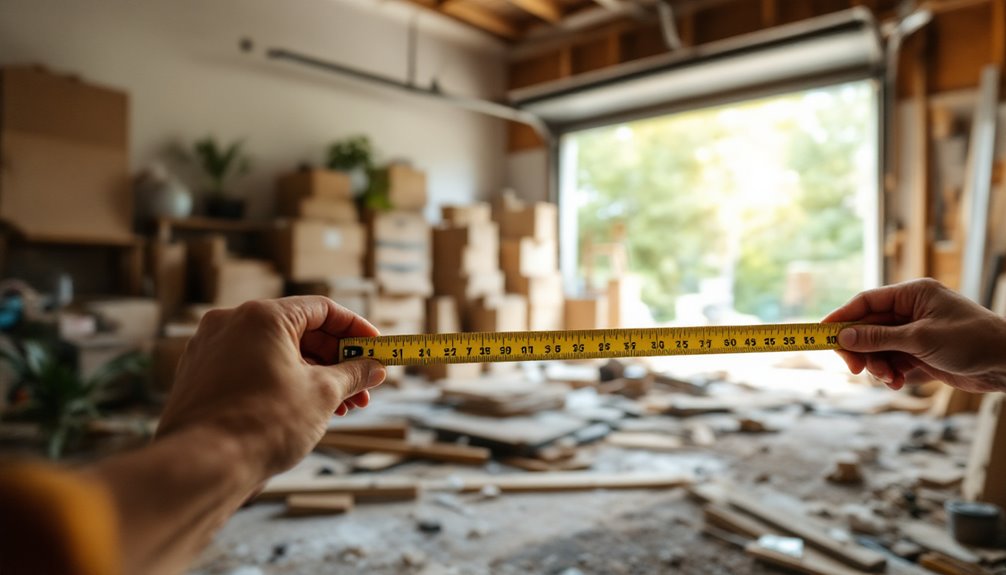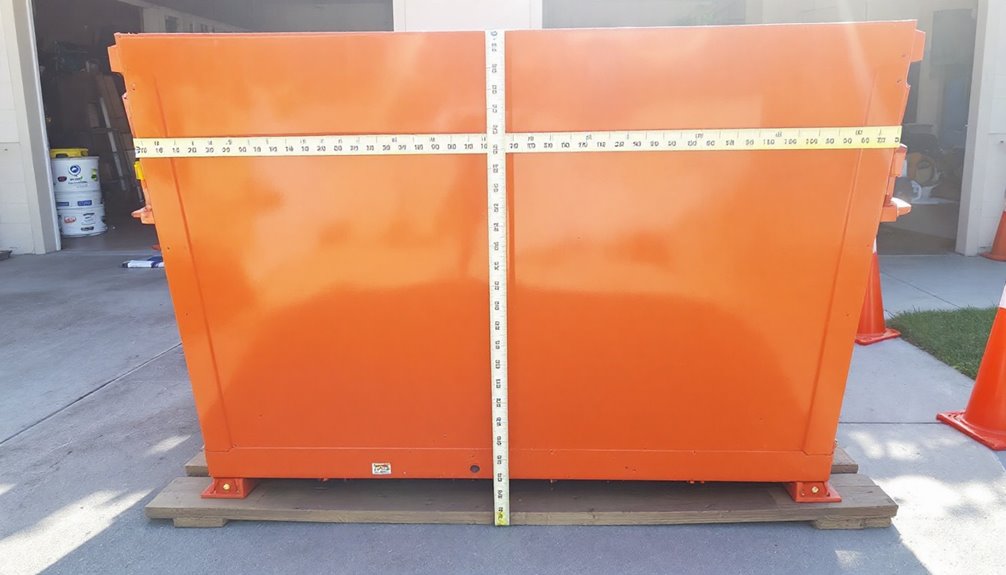To rent a dumpster, you’ll first need to evaluate your project’s waste requirements and timeline. Next, select an appropriately sized container based on your materials and volume needs. Research local rental companies to compare prices and services, then schedule your delivery with clear instructions for placement. Once delivered, follow proper loading guidelines and safety protocols. Understanding these key steps will help you navigate the entire rental process with confidence.
Key Takeaways
- Calculate required dumpster size based on project scope and waste types using length x width x height formula.
- Research rental companies to compare pricing, read reviews, and confirm service availability in your area.
- Schedule delivery at least one week ahead and prepare a level, accessible space for dumpster placement.
- Load dumpster properly with heavy items at bottom, staying within fill line and avoiding prohibited materials.
- Coordinate pickup with rental company once dumpster is filled or rental period ends.
Evaluating Your Project Requirements

When planning a dumpster rental, you’ll need to carefully assess your project’s scope and requirements to guarantee you get the right solution. Start by measuring your project’s scale, including square footage and expected timeline. Consider how many workers and pieces of equipment you’ll have on-site, as these factors directly impact waste generation. 20 cubic yard dumpsters are perfect for small residential projects and can hold up to 6,000 pounds of debris.
Break down your project into phases and identify the types of waste you’ll produce at each stage. You’ll want to account for various materials like concrete, wood, metals, and general debris. Don’t forget to check local regulations regarding waste disposal and evaluate your site’s accessibility for dumpster placement. Connect with contractors who’ve handled similar projects to gain practical insights into waste volume expectations and peak periods. Consider using waste stream segregation to efficiently manage different types of construction materials.
Selecting the Right Size and Type of Dumpster
The success of your waste management project hinges on choosing the right dumpster size and type. You’ll want to match your project’s needs with the appropriate capacity to avoid costly mistakes. For home decluttering or garage cleanouts, a 10-yard dumpster will serve you well, while kitchen renovations typically require a 20-yard container.
To determine your needs, calculate the volume of waste using this simple formula: length x width x height divided by 27. Remember that one cubic yard holds about 5-6 standard trash bags. Consider both the bulk and weight of your materials, as heavy items like concrete may hit weight limits before filling the container.
For reference, a 10-yard dumpster equals about three pickup truck loads, while a 40-yard container handles twelve loads.
Researching and Comparing Rental Companies

Selecting a reliable dumpster rental company requires thorough research across multiple factors. You’ll want to start by evaluating each company’s reputation through customer reviews, testimonials, and their track record of resolving issues. Compare pricing structures carefully, making sure you understand all potential fees and available discounts.
Pay close attention to the quality of customer service – you’ll be working with these professionals throughout your rental period. Look for companies that are responsive, helpful, and provide clear guidance on proper dumpster use. Also, guarantee they’re flexible with delivery and pickup times in your area.
Don’t forget to verify their service availability in your location and whether they can accommodate any special requirements you might have. Check if they accept the type of waste you’re planning to dispose of.
Scheduling and Preparing for Delivery
Once you’ve chosen your dumpster rental company, proper scheduling and preparation will ascertain a smooth delivery process. You’ll need to coordinate the rental period, typically 7-10 days, and select a convenient delivery time between 6 a.m. and 6 p.m. on weekdays.
| Timeline | Your Tasks | Communication |
|---|---|---|
| 1 Week Before | Clear space & mark area | Notify neighbors |
| 3 Days Before | Place lumber if needed | Confirm delivery details |
| 1 Day Before | Remove obstacles | Set reminders |
| Delivery Day | Verify access | Meet driver with instructions |
Don’t forget to prepare the delivery location by clearing a flat space and removing any obstructions. If you’re placing the dumpster in your driveway, move vehicles to the street and protect the surface as needed. Sort your materials beforehand to maximize efficiency once the dumpster arrives.
Understanding Proper Usage and Safety Guidelines

Proper safety protocols and usage guidelines form the foundation of successful dumpster rental projects. You’ll want to position your dumpster on stable, level ground away from your house and potential hazards, ensuring easy truck access for pickup.
When loading, follow the fill line and create a stable base with heavier items at the bottom. Stack materials neatly and distribute weight evenly to maximize space. Don’t forget to keep prohibited items out of the mix, including hazardous waste and electronics.
Always wear appropriate protective gear like gloves and safety glasses while working. Keep children away from the area, and never enter the dumpster alone. Stay in close communication with your rental company about waste types and pickup schedules, and you’ll avoid extra fees while keeping your project running smoothly.
Frequently Asked Questions
What Happens if Severe Weather Occurs During My Dumpster Rental Period?
You’ll need to secure the dumpster by closing the lid, anchoring it down, and removing loose items nearby. Stay updated on weather reports and contact your rental company if any issues arise.
Can I Move the Dumpster to a Different Location After Delivery?
You can’t move the dumpster yourself – it’s unsafe and against policy. Contact your rental company to schedule a professional relocation, though additional fees will apply for this service.
Do I Need to Be Present When the Dumpster Is Delivered?
You don’t need to be present during dumpster delivery if you’ve provided clear placement instructions. Just guarantee the drop-off area is accessible and free from obstacles before the scheduled delivery time.
What Happens if Someone Illegally Dumps Trash in My Rented Dumpster?
You’re responsible for all contents in your rented dumpster, but you can protect yourself by documenting illegal dumping, reporting it immediately, and installing cameras to catch offenders.
Are There Special Requirements for Renting a Dumpster in Winter Conditions?
You’ll need to clear snow around the dumpster area, guarantee stable ground, use salt for slip prevention, and add proper lighting. Consider covering the dumpster to prevent snow accumulation and ice buildup.
Conclusion
You’re now equipped to handle your dumpster rental with confidence. Remember to carefully assess your needs, choose the right size, find a reputable company, and follow all safety guidelines. By understanding the rental process and maintaining clear communication with your provider, you’ll guarantee a smooth experience from delivery to pickup. Don’t forget to check local regulations and obtain necessary permits before starting your project.